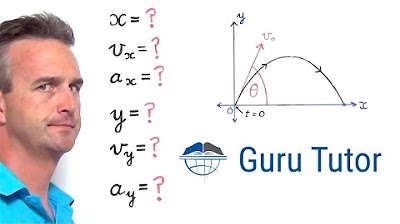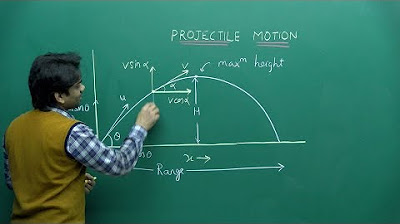Range Equation Derivation
TLDRThe video script delivers a clear and methodical explanation of how to derive the range equation from the horizontal and vertical components of motion equations. It begins by decomposing the initial velocity into its x and y components, then utilizes the horizontal and vertical motion equations to solve for the range. The derivation cleverly employs trigonometric identities, particularly sine 2θ, to arrive at the final form of the range equation, demonstrating the relationship between initial velocity, gravity, and the angle of projection.
Takeaways
- 📚 The range equation is derived from the horizontal and vertical components of motion equations.
- 🚀 Initial velocity is broken down into its x (vx) and y (vy) components using sine and cosine of the launch angle (theta).
- 🧭 The horizontal equation is delta x equals v_initial times delta t, while the vertical equation includes acceleration (gravity) in its calculation.
- 🔄 The range equation only works when there is no change in height, meaning the projectile does not gain or lose altitude.
- 🌐 The vertical component (vy) is calculated as v_initial times sine of theta, and the horizontal component (vx) as v_initial times cosine of theta.
- 🔢 By solving the vertical equation for delta t and substituting into the horizontal equation, we can express range (delta x) in terms of the initial velocity and launch angle.
- 📈 The derived range equation is delta x equals v_initial squared times sine 2 theta over the acceleration due to gravity.
- 🌟 A trigonometric property simplifies the equation, where cosine theta times sine theta times 2 equals sine 2 theta.
- 🎯 In projectile motion problems, the acceleration is considered as gravity, which always acts downwards towards the ground.
- 📊 The final simplified range equation is delta x equals v_initial squared times sine 2 theta over gravitational acceleration, which is fundamental for analyzing projectile motion.
Q & A
What is the formula for range in the context of projectile motion?
-The formula for range (delta x) in the context of projectile motion is given by: delta x = (v_initial^2 * sin(2 * theta)) / gravity.
How is the initial velocity broken down in the analysis of projectile motion?
-The initial velocity is broken down into its horizontal (vx) and vertical (vy) components. vx = v_initial * cos(theta) and vy = v_initial * sin(theta), where theta is the launch angle.
What are the standard horizontal and vertical motion equations used in the derivation of the range equation?
-The standard horizontal motion equation is delta x = v_initial * delta t, and the vertical motion equation is delta y1 = v_initial * delta t + (1/2) * acceleration * (delta t)^2.
Why is the change in height (delta y) set to zero in the derivation of the range equation?
-The change in height (delta y) is set to zero because the range equation only works when there is no change in height, which means the projectile is launched from and returns to the same height.
How does the direction of gravity affect the acceleration term in the vertical motion equation?
-The direction of gravity affects the acceleration term as a negative value because gravity acts downwards, which is considered the negative direction when 'up' is defined as positive.
What is the significance of the trigonometric identity used in simplifying the range equation?
-The trigonometric identity cos(theta) * sin(theta) * 2 equals sin(2 * theta) is used to simplify the range equation, making it more concise and easier to understand.
Why is acceleration considered as gravity in the context of projectile motion problems?
-In projectile motion problems, the only acceleration acting on the object is due to gravity, which is always directed downwards towards the ground. Hence, acceleration is considered equal to the acceleration due to gravity.
How does the horizontal component of velocity (vx) affect the range of the projectile?
-The horizontal component of velocity (vx) directly influences the range as it is multiplied by the time of flight (delta t) in the range equation. A larger horizontal velocity component results in a longer time of flight and thus a greater range.
What is the role of the launch angle (theta) in determining the range of a projectile?
-The launch angle (theta) is crucial in determining the range as it affects both the horizontal and vertical components of the initial velocity. The range is directly proportional to the sine of twice the launch angle, meaning that certain angles (like 45 degrees or pi/4 radians) will maximize the range.
How does the initial velocity (v_initial) impact the range of the projectile?
-The initial velocity (v_initial) has a significant impact on the range as it appears in the numerator of the range equation. An increase in the initial velocity will result in an increase in the range, assuming other factors such as gravity and the launch angle remain constant.
What is the relationship between the horizontal and vertical components of velocity in the context of projectile motion?
-The horizontal and vertical components of velocity are related through the launch angle and the initial velocity. They are derived from the initial velocity using trigonometric functions, with the horizontal component (vx) being the product of the initial velocity and the cosine of the launch angle, and the vertical component (vy) being the product of the initial velocity and the sine of the launch angle.
Outlines
🔢 Deriving the Range Equation
This section explains the process of deriving the range equation used in projectile motion problems by breaking down the initial velocity into its horizontal and vertical components. The narrator begins by introducing the known range equation, Δx = v_initial^2 * sin(2θ) / g, and proceeds to explain how to derive it from basic principles. This involves decomposing the initial velocity (v_initial) into its x (vx) and y (vy) components using trigonometric functions, specifically sine and cosine in relation to the angle θ. The equations for horizontal and vertical motion are then employed to express the range (Δx) in terms of time (Δt) and acceleration due to gravity. An error in variable naming is corrected, emphasizing the importance of distinguishing between the components of velocity (vx and vy) when applying these equations. The narrator clarifies the conditions under which the range equation applies, specifically when there is no change in vertical position (Δy = 0), and how to manipulate the equations to solve for the time variable, which is then used to derive the final form of the range equation.
📐 Simplifying the Range Equation
In this part, the video script continues with the simplification of the derived range equation. The narrator explains how to integrate the previously determined components of velocity and time into the formula for range (Δx). By substiting vx and Δt into the range equation, they show the mathematical process that leads to the simplification of the equation, using trigonometric identities to further condense the formula. This process results in the final simplified range equation, Δx = v_initial^2 * sin(2θ) / g, which mirrors the initially presented range equation but is arrived at through a comprehensive derivation process. The narrator emphasizes the applicability of this equation to projectile motion problems where gravity is the sole acceleration, reinforcing the concept that this formula is specifically tailored for scenarios where the projectile's vertical position does not change.
Mindmap
Keywords
💡Range Equation
💡Horizontal and Vertical Components
💡Trigonometry
💡Projectile Motion
💡Acceleration
💡Initial Velocity
💡Delta X (Range)
💡Sine and Cosine
💡Derivation
💡Equations of Motion
💡Gravitational Acceleration
Highlights
Derivation of the range equation from horizontal and vertical motion equations.
Breaking down initial velocity into x and y components using sine and cosine of theta.
The horizontal equation: delta x equals v initial times delta t.
The vertical equation: delta y1 is v initial times delta t plus one half acceleration times delta t squared.
Rewriting the vertical equation to solve for delta t in terms of delta y and acceleration.
Simplifying the equation by dividing by one half acceleration and expressing delta t in terms of initial velocity and sine of theta.
Using the horizontal equation to express delta x in terms of vx, which is cosine theta times v initial.
Substituting the derived expression for delta t into the horizontal equation to find delta x.
Simplifying the range equation by canceling out the common factor of initial velocity.
Utilizing the trigonometric identity of cosine theta times sine theta times two equals sine two theta to further simplify the range equation.
The final form of the range equation: delta x equals initial velocity squared times sine 2 theta over acceleration (gravity).
The importance of the reference point in determining the positive or negative sign of acceleration in the equations.
The condition for the range equation to be valid: no change in height (delta y must be zero).
The practical application of the range equation in projectile motion problems where gravity acts downwards.
The method for deriving the range equation is applicable to various projectile motion scenarios.
The significance of understanding both horizontal and vertical components of motion to accurately derive and apply the range equation.
Transcripts
Browse More Related Video

Where Does The Range Equation Come From?

Deriving the Range Equation of Projectile Motion

AP Physics B Kinematics Presentation #74

Why Does 45º Launch Angle Give Maximum Range? // HSC Physics

Deriving the 6 Basic Projectile Motion Equations

NEET Physics | Projectile Motion | Theory & Problem-Solving | In English | Misostudy
5.0 / 5 (0 votes)
Thanks for rating: